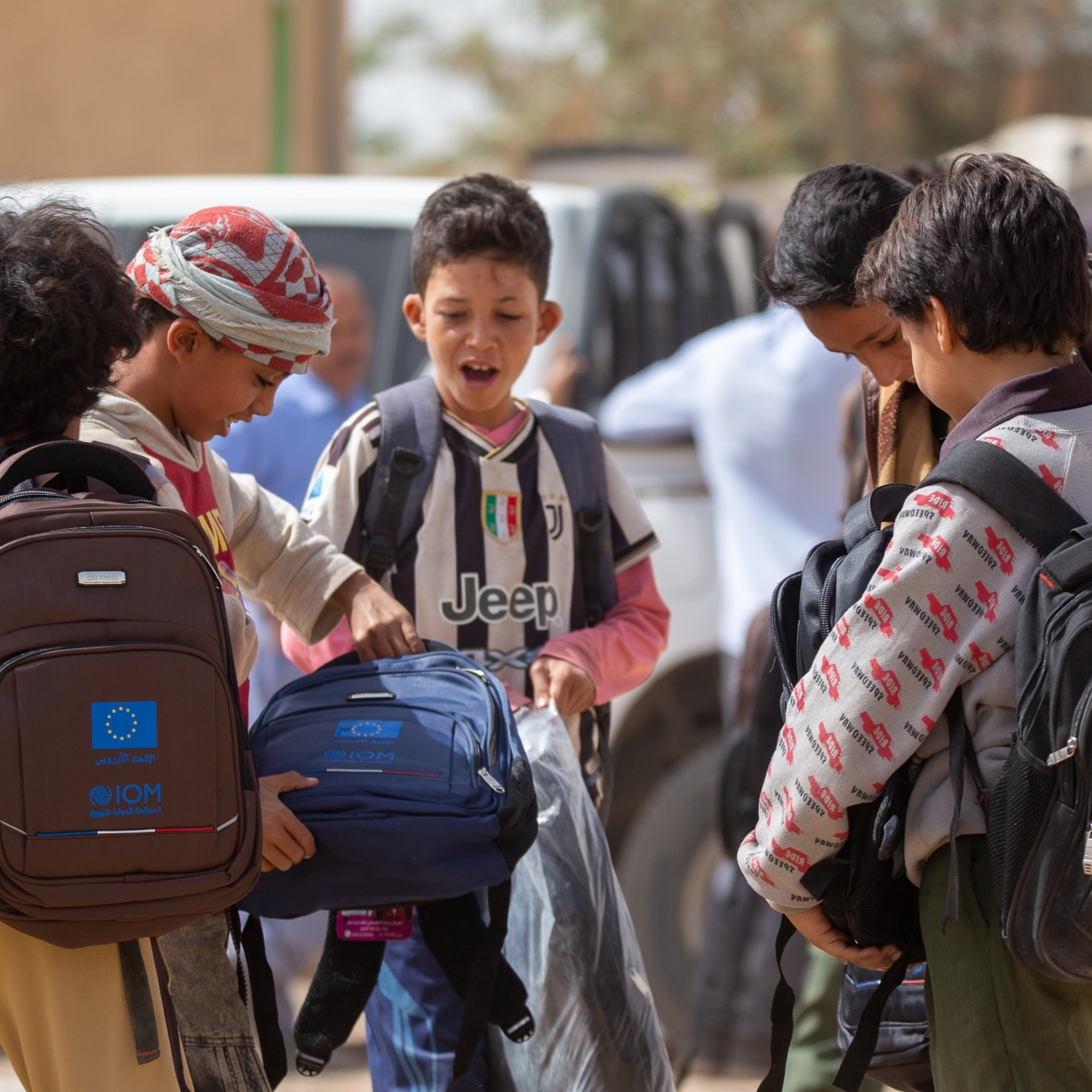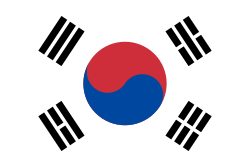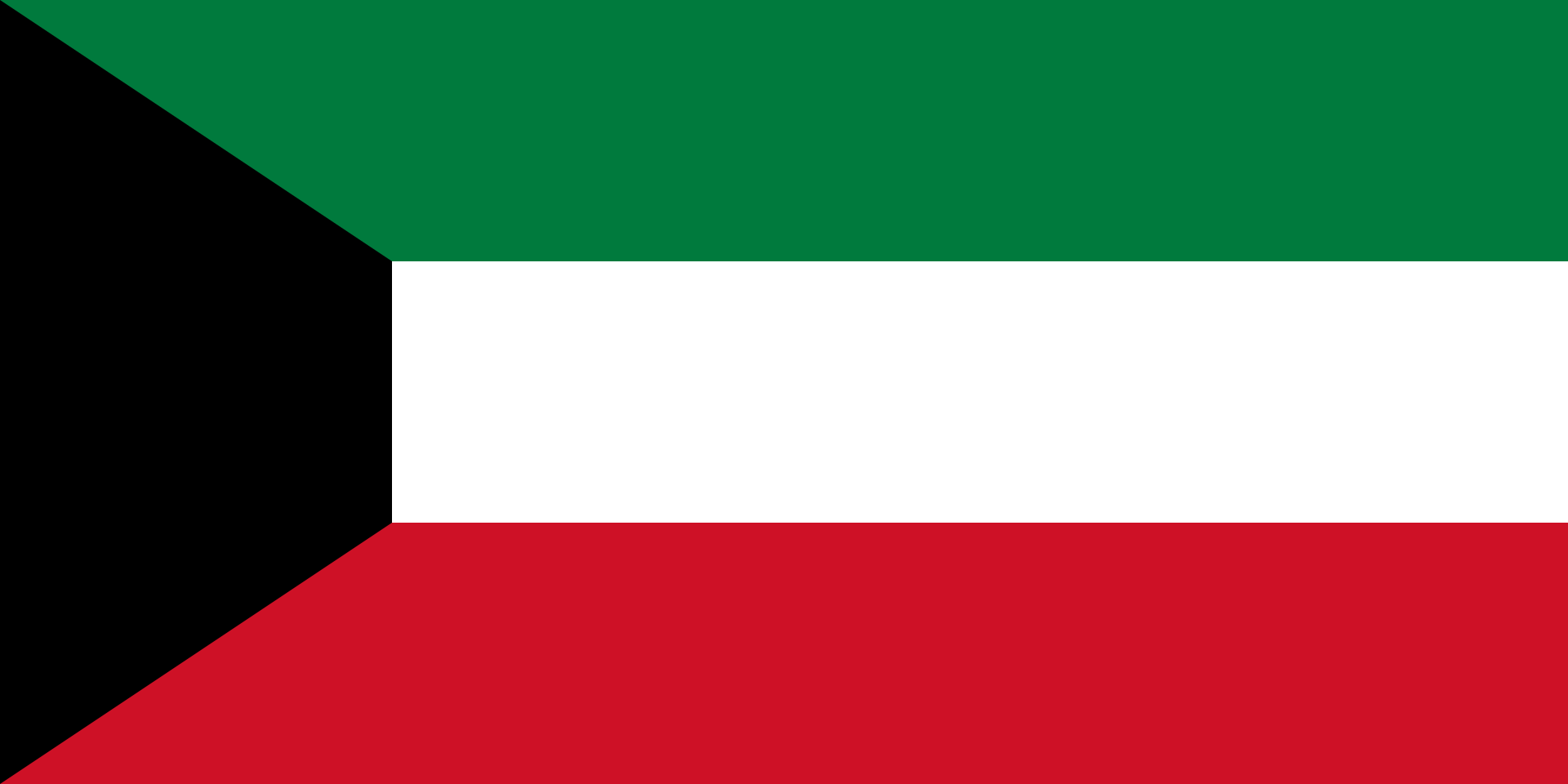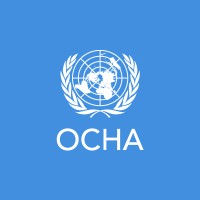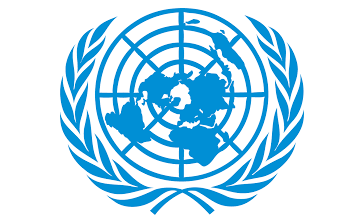IOM Vision
In 2024, IOM in Yemen will continue responding to vast humanitarian and protection needs through the provision of lifesaving multisectoral humanitarian and specialized protection assistance in addition to supporting communities transition from a state of crisis to recovery. IOM will seek to meet immediate needs while simultaneously addressing the pre-existing drivers of fragility and improving access to durable solutions, in an effort to reduce the reliance of populations of concern on humanitarian aid. In conjunction with a frontline response, IOM supports the restoration of household and public infrastructure to enhance communities’ self-sufficiency and promote local ownership of recovery efforts.
Objective
Saving lives and protecting people on the move
In areas of ongoing insecurity, new displacements or acute, underserved needs, direct humanitarian assistance is sometimes the only lifeline for survival. In these instances, IOM provides emergency services and protection assistance through direct implementation and strategic project partners, balancing considerations around access, response capacities and needs. IOM will target displaced, crisis-affected persons, vulnerable migrants, at risk groups and host communities based on the specific vulnerability criteria of the intended intervention.
The selection criteria of beneficiaries, as well as the assistance provided, are grounded in area-based analysis and prioritization of threats, risks and vulnerabilities related to the drivers and impacts of displacement, migration and conflict. IOM will aim to target those most in need including female-headed households, persons with disabilities, older people, people who have not yet received assistance, and households with other vulnerabilities. IOM will ensure to assess key protection risks with a focus on mitigating risks of gender-based violence and improving access to related specialized services for survivors of gender-based violence.
IOM aims to strengthen community capacities to mitigate, prepare and rapidly respond to disasters that negatively impact the lives and livelihoods of vulnerable groups across Yemen, placing heavy emphasis on the participation of local communities. IOM will consider the impact on vulnerable groups and look to strengthen mitigation of risks related to gender-based violence and other protection concerns as part of these efforts. In support of these efforts, IOM will also provide capacity-building activities on early warning, emergency preparedness and response to local authorities to enhance their skills and equip them with the necessary tools in preparing and responding to disasters, targeting two key Government entities.
IOM in Yemen’s programming is centred around a needs-based approach, supported by independent data collection to ensure interventions meet the needs of target populations. IOM will prioritize consideration of the specific needs of the most vulnerable in assessments, including survivors of gender-based violence. With support from its Displacement Tracking Matrix (DTM) as well as targeted sectoral needs assessments and a strong network of operational teams, IOM seeks to ensure up to date and reliable information is available to ensure emergency preparedness and response capacity to major shifts in the crisis. IOM will target local authorities and humanitarian and development actors, including national and international partners who receive and benefit from DTM products.
IOM will continue to implement CCCM activities in Yemen that improve the living conditions of displaced families living in formal and informal sites, collective centres, communal buildings and spontaneous settlements. Activities will be centered around ensuring adequate community mobilization and capacity-building; site care and maintenance; and coordination and service monitoring. The CCCM teams will lead the coordination of integrated service delivery in sites, ensuring that IDPs have access to multisectoral services in line with the Minimum Standards in Camp Management (MSCM). IOM also will provide technical advice and capacity building for authorities acting as camp administration, IDP camp committees, and national NGOs working in site management. In 2024, IOM will continue to:
- Conduct regular monitoring of needs, maintain comprehensive mapping of site-level service gaps, and establish a site-level complaint and feedback mechanism.
- Conduct regular care and maintenance of site infrastructure with a focus on mitigating the impact of seasonal flooding, reducing the risk of the spread of diseases, increasing site safety, through electrical upgrades, solar lights installation, and fire risk reduction, and improving service delivery. Infrastructure works will include measures to reduce GBV risks (lighting, location, etc.).
- Conduct community mobilization and capacity-building, including awareness-raising on preparedness and response, encouraging community participation, and creating opportunities for often excluded groups, such as women, persons with disabilities, and youth, to take part in camp leadership and other empowerment initiatives.
- Set up and or reinforce representative community governance structures to promote community participation in sites, including promoting the active involvement of marginalized groups, e.g. women and persons with disability, in decision-making processes to ensure a fair, community-centered, and needs-based response. Sub-activities within community participation include the setup and capacity-building of representative community groups; awareness campaigns on topics related to service provision, beneficiary rights, prevention of sexual exploitation and abuse (PSEA), site safety and complaints and feedback mechanisms to ensure two-way communication with the IDPs; and on-the-job skill training for IDPs.
- Support local capacity among authorities, organizations and community leaders in site management for purposes of future site handover and management.
- As hundreds of settlements in Yemen remain without camp management partners, look to expand CCCM coverage to support unmanaged sites suffering from a lack of basic services.
In line with UN frameworks and in coordination with the Ministry of Public Health and Population (MoPHP), the Health Cluster and World Health Organization (WHO), IOM will continue to provide lifesaving primary and secondary preventative and curative health-care services to IDPs, migrants and host communities. In 2024, IOM will:
- Provide essential primary and secondary healthcare through IOM mobile and static primary and secondary health facilities across the country (where access permits).
- Provide essential operational support (supplies, equipment, incentives) to static health facilities to enhance intake capacity, including reception, registration, and internal referral, medicines and medical supplies in line with national and Cluster standards.
- Ensure rational access to secondary and tertiary healthcare through an ambulance referral system for emergency medical cases.
- Support mass and routine vaccinations
- Encourage healthy living, improve health seeking behaviour and utilization of the essential health service package among IDPs, migrants and host community through trained community health volunteers.
IOM will continue to provide safe, dignified and voluntary humanitarian return assistance for stranded migrants (the majority of whom are Ethiopian) and Somali refugees in Yemen through a range of health and protection support – including case management, pre-migration health activities, and medical escorts during air travel, provision of information, and re-integration assistance upon arrival. In 2024, IOM will:
- Assist migrants with their safe, voluntary and dignified return from Yemen to their countries of origin through IOM’s voluntary humanitarian return (VHR) programme. Priority will be given to the most vulnerable, such as unaccompanied and separated children (UASC), women, older people, medical cases, and persons who have been subjected to a series of grave human rights violations. All migrants interested in VHR assistance will be individually counselled in Yemen by protection case managers and provided with the necessary information to make an informed decision in line with their needs. IOM provides screenings for protection issues – especially for persons vulnerable to trafficking – and provides specialized referrals of protection and medical cases, including for migrants who require further medical support from secondary and/or tertiary care facilities. IOM medical teams will conduct ‘fitness to travel’ pre-embarkation checks in preparation for participation in VHR.
As the situation for all populations of concern in Yemen continues to deteriorate, and exposure to protection risks rise within displaced and conflict-affected communities, IOM will aim to enhance the protection environment, build capacity, reduce vulnerability and support responsive mechanisms for those most at risk. In 2024, IOM will:
- Continue to strengthen protection mainstreaming and GBV risk mitigation across all multisectoral programming, and train staff, partners and duty bearers on protection standards including safe identification and referrals.
- Scale up direct assistance through establishing and/or expanding migrant response points (MRPs), community response points, protection desks, and mobile response teams.
- Across Yemen, continue to provide protection case management, protection monitoring, specialized service provision and referrals for persons at risk to services including legal aid, MHPSS, medical assistance among others to address immediate needs for survivors of GBV, unaccompanied or separated children, victims of trafficking and other vulnerable people.
- Improve access to information on civil status documentation and individuals’ rights and entitlements.
- Reinforce community-based protection networks and community protection committees for the sustainable, community-driven identification, response, prevention and referral of protection cases. IOM will conduct protection advocacy targeted towards key partners against the human rights abuses and inhumane treatment of vulnerable migrants in Yemen, promote access to essential service for migrants and continue to support the development of long-term protection-sensitive and rights-based solutions in Yemen.
IOM’s WASH programme in Yemen will prioritize immediate, scalable, and sustainable interventions aimed at reducing morbidity and mortality rates and providing equal and sustained access to safe and appropriate water, sanitation, and hygiene services in displaced, host, and migrant communities. In 2024, IOM will:
- As part of its emergency response, deliver life-saving WASH support in displacement sites and underserved/hard-to-reach areas to address high WASH needs and gaps in services. Activities will include emergency water supply, rapid rehabilitation of water supply systems and sanitation infrastructure, and solid waste collection and disposal among other interventions.
- Mainstream WASH infection prevention, and control activities into existing and planned interventions when required in response to disease outbreaks.
- Conduct sensitization campaigns and ensure that communities have the tools necessary to protect themselves from WASH-related diseases including, but not limited to, water-borne diseases such as cholera, vector-borne diseases such as malaria, and communicable diseases.
With the overall objective of providing safe, dignified and sustainable living conditions and shelter solutions in IDP settlements, IOM will carry out its first line emergency response activities following the onset of emergencies and in formal/informal settlements where shelter conditions are inadequate. IOM will utilize both in-kind and cash-based modalities (where feasible and appropriate) to support target households. In 2024, IOM will:
- Distribute critical household items, emergency shelter kits (ESKs) and family tents to vulnerable populations affected by conflict or disasters in response to new displacements or shocks, or to cover response gaps in displacement sites, including IDPs, host communities, persons living in sub-standard shelters and inadequate living conditions.
- Where IDPs have been displaced for over six months, IOM will provide shelter items and technical support for transitional shelters or rehabilitate existing shelters in line with full Housing, Land, Property (HLP) Due Diligence.
- Carry out rehabilitation of damaged and/or worn-out emergency shelters. Emergency shelter rehabilitation activities will promote the dignity of vulnerable groups and protect IDPs from harsh weather conditions by installing thermal insulation on walls and roofs as well as ground insulation in shelters.
- Facilitating the provision of coordinated, timely and relevant life-saving humanitarian assistance to the most vulnerable by ensuring the common procurement of essential relief items.
IOM’s cash programme supports conflict-affected individuals through rapid cash-based interventions to meet basic needs. Cash-based interventions are closely integrated into various areas of IOM programming, such as CCCM, S-NFI, WASH, and protection. In 2024, IOM will:
- Distribute multi-purpose cash assistance (MPCA) and continue its co-leadership of the Rapid Response Mechanism (RRM) cluster (together with the United Nations Populations Fund) and the Cash Consortium of Yemen (CCY).
- Provide rapid earning opportunities through cash for work to unskilled and semi-skilled individuals, with a focus on the inclusion of women, on projects designed to improve the living conditions in conflict-affected communities. These mainly include the rehabilitation of water and sanitation systems, irrigation systems, shelter structures, and rehabilitation of basic community infrastructure.
To increase capacity and readiness to respond to emergencies, IOM will aim to build upon efforts undertaken in 2023 to enhance early warning early action systems by strengthening the capacities of civil protection groups, local response partners and communities across Yemen in addition to pre-positioning of relief items and providing continued support to mitigate and address disease outbreak. In 2024, IOM will:
- Conduct risk analysis including hazard and resource mapping to identify hazards and relevant gaps in services and response including warehouse capacity, prepositioning capability, and accessibility of relief items at the state and community levels.
- Enhance dissemination and communication of alerts to communities before disasters through early warning systems and public awareness campaigns.
- Improve communities/civil protection groups’ preparedness to respond to crises through strengthening capacity on monitoring and evaluation, reporting, warehouse management, early warning/action tools and coordination among other key aspects.
- Procure, preposition, and distribute key supplies and items to rapidly response to emergencies.
- Ensure disease outbreak preparedness and response in collaboration with IOM’s WASH programme’s hygiene promotion activities.
In the context of Yemen, impartial and high-quality assessments, data collection and analysis are essential to inform assistance provision based on identified needs and vulnerabilities. IOM operates the largest displacement tracking and monitoring mechanism in the country, which enables a targeted, evidence-based response for not only IOM, but also the entire humanitarian response. IOM Yemen’s Displacement Tracking Matrix (DTM) provides critical, up-to-date information on movement trends and the needs of migrants and vulnerable and displaced populations, aiming to provide humanitarian and development actors as well as local authorities and research institutions actionable and reliable information on IDPs and returnees, including their numbers, locations, cause of displacement and priority needs. In 2024, IOM will:
- Conduct Rapid Displacement Tracking and Area Assessments: This tool will track IDP, IDP returnee and migrant populations throughout Yemen. Information will be collected regularly on areas of displacement and return, origins and reasons for displacement, shelter types, situation overviews and priority needs at target locations. The Rapid Displacement Tracking (RDT) tool will track trends daily while Area Assessments, under the umbrella of Mobility Tracking, are carried out twice a year.
- Carry out flow monitoring: DTM’s Flow Monitoring Registry (FMR) will monitor the arrival of migrants transiting through Yemen, mainly in locations across Yemen’s southern coastal border and at the northern border with the Kingdom of Saudi Arabia (KSA). In addition, Flow Monitoring Surveys (FMS) will be used in conjunction with Participatory Migrant Mapping (PMM) to gain a more in-depth understanding of the profile, journey and intention of migrants in Internationally Recognized Government (IRG) areas.
- Implement Multi-Cluster Location Assessments (MCLA): IOM DTM will collaborate with the United Nations Office for the Coordination of Humanitarian Affairs (OCHA) and other key humanitarian actors to implement the MCLA, which acts as a tool for the humanitarian community to address information gaps and improve evidence-based humanitarian resource allocation across geographical areas, sectors, and population groups. The MCLA will provide nationwide data and evidence-based findings to establish the needs in the country and be used as a baseline for humanitarian programming. The data collection exercise particularly supports the development of the Humanitarian Needs Overview (HNO) to better inform the Humanitarian Response Plan (HRP).
- Conduct Thematic Household Surveys: DTM will conduct thematic household surveys to support humanitarian and development actors to better understand needs and gaps in services.
In line with the S.G. Action Agenda on Internal Displacement, a series of structural reforms are required in the 15 pilot countries. As the mandate enters its final year in 2024, IOM will work closely with partners to support durable solutions planning and initiatives. In 2024, IOM will:
- Work closely with partners to support the production of area-based solutions strategies.
- Further support data collection to inform durable solutions for programming, in line with the recommendations of the Data for Solutions to Internal Displacement (DSID) Taskforce including conducting the local integration and intention survey in consultation with and under the umbrella of the Durable Solutions Working Group.
IOM’s mental health and psychosocial support (MHPSS) services will aim to ensure crisis-affected populations have access to timely and adequate services, ultimately supporting improved mental health and psychosocial wellbeing of IDPs, migrants and host community members. In 2024, to provide multilayered MHPSS in line with the Inter-Agency Standing Committee (IASC) guidance on MHPSS in emergencies, IOM will:
- Where possible, provide mental health services for people with moderate to severe mental health conditions, including referrals to and direct psychiatric consultations and treatments.
- Strengthen capacity to identify, refer, treat and follow up with people with severe mental disorders. This includes capacity-building for health workers in psychological first aid (PFA) and identification of individuals with MHPSS needs.
- Provide focused MHPSS services, including individual and group counselling by psychologists, and remote counselling via a hotline.
- Conduct community-based MHPSS activities, including socio-relational activities, psychoeducation sessions, and information campaigns in health facilities and during community outreach activities.
- In coordination with the Ministry of Health and Population, provide capacity-building for frontline workers and community members in basic psychosocial skills including PFA.
- Improve and/or establish referral pathways for MHPSS services.
- Support safe and private spaces for MHPSS services at existing health facilities and within IDP sites.

Objective
Driving solutions to displacement
IOM seeks to improve access to durable, life-sustaining assistance that both reduces beneficiaries’ reliance on humanitarian aid and enhances their self-sufficiency to transition from emergency to recovery conditions. In line with humanitarian-development-peace nexus approaches, and in conjunction with a frontline response, IOM supports the restoration of household and public infrastructure and services to enhance the capacities of individuals and communities to meet their own needs and promote local ownership of their communities’ recovery efforts.
Concurrently, IOM strengthens the capacity of community-based organizations and groups, civil society and local/regional public service providers to deliver basic services. IOM aims to target displaced persons, migrants, and host community members under this objective. To ensure sustainability, IOM will also target at least five government entities including but not limited to the Ministry of Foreign Affairs, Ministry of Public Health and Population (MoPHP), Ministry of Education, the Executive Unit (EXU), and the Immigration, Passports and Naturalization Authority (IPNA) with capacity-building and/or equipment to improve the recovery efforts in crisis-affected communities.
Through a locally driven approach, including the participation of target communities, IOM will select target locations based on assessments to identify vulnerable communities with the highest needs for the specific project intervention.
IOM aims to strengthen community capacities to mitigate, prepare and rapidly respond to disasters that negatively impact the lives and livelihoods of vulnerable groups across Yemen. IOM puts heavy emphasis on the participation of local communities in actions related to early warning, emergency preparedness, disaster risk management (DRM) and response. IOM endeavours to establish community level volunteer groups targeting seven vulnerable, disaster-prone communities to support and complement the efforts of the mandated first responding state agency (Civil Defence Authority) through sustained capacity-building training and simulation and the provision of the appropriate tools, materials and equipment. Impacts on vulnerable groups will be specifically considered with a view to strengthening efforts to mitigate risks related to gender-based violence and other protection concerns as part of these efforts.
IOM will also provide capacity-building activities on early warning, emergency preparedness, DRM and response to local authorities to enhance their skills and equip them with the necessary tools in preparing and responding to disasters. As part of these efforts, IOM intends to target two government entities including but not limited to the Executive Unit and the Civil Defence Authority with capacity-building and/or equipment to improve the early warning, prepared, response and recovery efforts in crisis-affected communities.
In line with a humanitarian-development peace nexus approach, IOM will support communities to recover from a state of crisis and transition towards resilience and community-led and owned solutions that meet immediate and long-term development needs. IOM will rehabilitate key public infrastructures and increase access to services in pockets of stability. Rehabilitated public infrastructure in need of support will be identified utilizing a community-led approach. Furthermore, IOM will support conflict resolution mechanisms and other initiatives that promote social cohesion. In 2024, IOM will:
- Empower communities to prevent and resolve conflict, as a driver of crisis and displacement, by identifying root causes, building local stakeholders’ mediation capacity and facilitating conflict resolution and social cohesion activities. IOM’s planned activities may include, but are not limited to, the implementation of peacebuilding initiatives, establishment/strengthening of women’s committees and water user associations, conducting conflict analysis to identify sources of tension, and building local capacity to manage water and other communal resources.
- Deliver livelihood interventions and improve access to income to reduce affected groups’ reliance on humanitarian aid and enhance their self-sufficiency to transition from emergency to recovery conditions. IOM will provide cash-for-work and multi-purpose cash assistance, business and vocational training, and small business start-up kits, as well as enhancing community livelihood assets such as local markets and agricultural infrastructure. The injection of cash into the local markets as well as the provision of dignified employment opportunities will facilitate the economic restoration of communities impacted by the conflict.
- Expand vocational training facilities including infrastructure rehabilitation and the provision of appropriate tools, equipment and capacity-building training to improve curriculum and increase the number of trained trainers.
- Restore and preserve basic service delivery by rehabilitating community assets, providing materials and supplies for public service providers, and building the capacity of local stakeholders, including public workers, local officials, civil society and community groups, to sustainably address community needs.
- Expand interventions aiming to reduce barriers to accessing education, by providing sustainable inputs to improve school infrastructure that will foster increased intake capacity and provide students with a safe learning environment. The efforts will include additional buildings and classrooms; various attached infrastructure, e.g. teachers' quarters, laboratory equipment, segregated school latrines, elevated water tanks, and solar panels; and provisions for solid waste disposal in these institutions.
In line with the Minimum Service Package (MSP) guidelines for Yemen, a component of IOM’s health programme is focused on supporting Yemen’s weakened health system – rehabilitating and supporting operations in health facilities impacted by the conflict by providing medicine, medical equipment and human resources (incentive payments for medical staff). In 2024, IOM will continue to support efforts to restore access to health services as follows:
- Support the strengthening of health systems (via provision of equipment, performance-based incentives and rehabilitation/maintenance to facilities) to provide maternal, child and newborn care, as well as routine immunization; nutrition support (including for severe acute malnutrition and moderate acute malnutrition); communicable/non-communicable disease prevention and support; emergency health and minor surgery; and disability and rehabilitation support.
- Train healthcare workers to provide an appropriate GBV response, and on MHPSS as well as safe identification and referrals (notably for vulnerable groups), in line with IOM's Manual on Community-based MHPSS in Emergencies and Displacement.
- Strengthen disease surveillance systems by sharing information with the Health Cluster early warning system and local health information management system.
- Expand the prevention, treatment, care and support for human immunodeficiency virus (HIV), tuberculosis (TB) and malaria response programming across the region. This will build upon gains made in 2023 as IOM was the principal recipient of the Global Fund Middle East Response grant in Yemen.
- Support advocacy for national policies and strategies to recognize and address the health needs and rights of migrants and their communities in line with international, regional and national commitments.
IOM will aim to reduce housing, land and property (HLP) risks including eviction threats, landlord disputes, and forced movement of displaced families living in the sites, as a measure to support more sustainable settlement solutions in the context of durable solutions for IDPs. In 2024, IOM will:
- Map out key HLP actors, local conflict dynamics, and risks to avoid future risks of eviction and HLP matters.
- Monitor eviction threats, identify HLP cases and refer them to relevant units and/or partners for support.
- Assist in negotiations with landlords and authorities (EXU) for displaced families facing eviction threats.
- Build the capacity of authorities, camp committees, local organizations, and partners on HLP.
As a measure to support durable solutions, IOM will continue to identify exit strategies that reduce depending on emergency WASH interventions and foster long-term access to water, sanitation and hygiene services. In 2024, IOM will:
- Support the construction and/or rehabilitation of water supply networks.
- Promote enhanced water resource management through improved ground water level monitoring and capacity building of local communities and actors.
- Support the establishment of community WASH committees to safeguard equitable service delivery.
- Provide capacity building to local water and sanitation authorities in addition to communities on the sustainable use and maintenance of water and sanitation systems
Through a community and needs-based approach, IOM will also aim to improve community resilience and adaptation, as well as mitigation and response to disasters through sustainable water infrastructure. In 2024, IOM will:
- Conduct an in-depth technical remote sensing flood risk and vulnerability mapping of target areas.
- Construct and rehabilitate public infrastructure (in areas not yet supported or where further works are needed), including rainwater runoff systems, retention walls, and spate irrigation, to mitigate the impact of climate change including unseasonal rainfall, flooding, and landslides. Special emphasis will be given to the reuse potential of flood water for agricultural purposes at the community level.
In the context of durable solutions, IOM will aim to conduct mental health and psychosocial activities that will support longer term recovery including through facilitating dialogues with affected communities and strengthening the capacity of MHPSS service providers. In 2024, IOM will:
- Strengthen MHPSS capacity by supporting health facilities and training of healthcare workers to assist IDPs, migrants and conflict-affected host community members.
- Provide, as part of community-based psychosocial support services, community and family support as well as culturally and socially appropriate activities including support groups and socio-relational activities such as creative and art-based, sport and play, and cultural activities, rituals and celebration among other activities.
- Support activities such as community dialogues among affected populations, including IDPs, returnees and host communities to enhance peaceful coexistence.
IOM will support at-risk communities to reduce disaster risks and utilize climate change adaption techniques to build the resilience of vulnerable communities to existing and future disaster risks. In 2024, IOM will:
- Strengthen communities’ risk detection and analysis and hazard forecasting, including observation, measurement, and prediction. Trainings will focus on monitoring and how communities/civil protection groups can continuously detect/identify risks (through meteorological warnings), report on these trends, forecast the impact, and identify the threshold to issue a warning.
- Establish and/or reinforce community-driven early warning systems (EWS).
- Train local authorities and selected community leaders on disaster risk reduction (DRR) to support community early recovery and raising awareness on disaster risk mitigation measures.
- Build capacity of communities, local government institutions and civil society organizations to develop and implement DRR and adaptation plans including rebuilding hazard-resistant shelters, risk-proofing critical community infrastructure and implementing structural DRR measures.
Yemen
The map used here is for illustration purposes only. Names and boundaries do not imply official endorsement or acceptance by IOM.
Figures are as of 31 December 2023. For more details of IOM's operational capacity in country, please see the IOM Capacity section.


